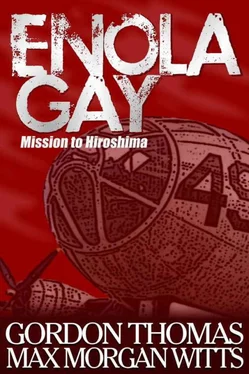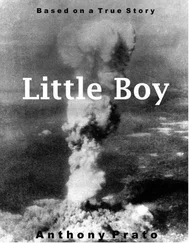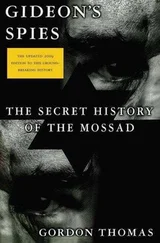Bullying, cajoling, bruising, buffeting, occasionally praising, and rarely apologizing, Groves had achieved a feat he himself had once thought impossible. In two years he had brought the atomic bomb from the blueprint stage to the point where it would soon be ready for testing.
Groves would allow no one to stop that momentum.
He had approved the choice of Tibbets as the commander of the special atomic strike force because he had all the professional qualities Groves believed were needed to get the job done.
Working from a temporary office in the Pentagon, Tibbets was coming to realize, a week after the meeting in Colorado Springs, just how vast his powers were as commander. He could demand anything he wanted, merely by mentioning the code name Silverplate. Using that prefix, he had instituted a search for some of the men who had served with him in Europe, North Africa, and on the B-29 testing and training program. Some had already been traced and were on their way to Wendover in Utah; others were having their orders cut.
Here, at the Pentagon, General Henry Arnold, chief of the Army Air Force, had said, “Colonel, if you get any trouble from anybody, you can call on me.”
Arnold had designated two senior officers to serve as liaison with Tibbets when he got to Wendover. Arnold’s order to them was simple. “Just give him anything he wants without delay.”
Tibbets had stopped at Wendover on his way from Colorado Springs to Washington. He found it “the end of the world, perfect.” It was close enough to Los Alamos by air, an important consideration, for Ramsey had warned him that “the scientists will be bugging you day and night.” It was only some five hundred miles by air from the Salton Sea area in Southern California, an ideal bombing range. The location of Wendover would simplify security. The existing facilities on the base were suitable for immediate occupancy.
He knew his men would hate the place.
But he planned to work them so hard that they would not have time to dwell on their surroundings.
By now, Tibbets had surmised there were only two possible targets for him to bomb: Berlin or Tokyo. He thought the Japanese capital more likely; the war in Europe was already approaching a decisive stage.
If it was to be Japan, then he would need a base within striking distance of the Japanese home islands.
He recalled reading that the U.S. Marines had recently captured the Mariana Islands in the Pacific. The newspapers had dubbed one island “the place where the Seabees are going to build the largest aircraft carrier in the world.” It was just thirteen hundred miles from Japan. Its name was Tinian.
Tibbets filed it in his memory.
The fall of Tinian in late July had totally failed to shake Second Lieutenant Tatsuo Yokoyama’s belief in the invincibility of the Imperial Japanese Army.
This September evening, as usual before gunnery practice, the forty men at the antiaircraft gun post on Mount Futaba, in the northeastern outskirts of Hiroshima, were lectured by their young commander on the need to keep faith with the high command’s belief in ultimate victory.
In appearance, Yokoyama at first glance seemed the classic caricature in countless American cartoons: buck teeth, slanted eyes, sloping forehead; a wiry figure in baggy blouse, with sloppy leggings encasing bandy legs.
But his image was deceptive. He was a crack rifle shot at seven hundred yards. He was capable of carrying four hundred rounds of ammunition—double that carried by an American infantryman—and trained to exist on a bowl of rice and fish a day. He regarded surrender as the greatest shame he could inflict upon his family and country. Deeply religious and hyperpatriotic, he devoutly believed in the divinity of the emperor and the sacred duty of the army to protect his majesty. He would not spare his family, his soldiers, or himself to serve the emperor.
Yokoyama had three heroes: first, Minoru Genda, the young officer who had convinced the high command that an unexpected, carrier-based air attack on Pearl Harbor was feasible and militarily desirable; second, Captain Mitsuo Fuchida, Genda’s close friend, who had led the 354 planes to Hawaii. Both had connections with the city where Yokoyama was now based. Genda had relatives in Hiroshima; Fuchida sometimes visited friends there. Yokoyama’s third hero was General Hideki Tojo, “The Razor,” Japan’s architect of war.
Yokoyama told his men that they should look upon the “withdrawal” from the islands of Saipan, Tinian, and Guam in the Marianas as a predetermined action, part of a carefully prepared plan to draw the enemy closer to Japan.
There, as they all knew, a vast army was waiting, and eager, to deal America and her Allies a blow which would send them reeling. The Americans could win a battle, he reminded his men, but Japan had never lost a war since 1598. He told them that the Japanese “departure” from the Marianas meant the day must be approaching when enemy bombers launched from there against Japan would at long last come within range of their guns.
In anticipation of that moment, he drove his bored gun crews hard. The men knew he would punish them severely at the first sign of slackness. Under his commands the guns moved smoothly on their greased bearings, their slim barrels traversing the air over Hiroshima.
Yokoyama passed among the gunners, urging them to imagine they were in action. Suddenly, one of the guns jammed. Yokoyama saw that a piece of waste cotton had been left in the mechanism. He halted the practice and furiously ordered the crews to strip, clean, and reassemble the guns. He then returned to his quarters to write up the incident in the daily report book and to think of a suitable punishment for the errant crew. He decided on two extra drills.
But first he would enjoy a ritual he performed every evening. At the window of his billet, he surveyed the city through binoculars. He knew there would have been little change during the last twenty-four hours, but the panorama always soothed him.
When he had first surveyed the city from his vantage point close to the crest of Mount Futaba a year before, Yokoyama had been struck by an oddity: Hiroshima resembled a human hand. By holding out his right hand, palm down, fingers spread, he reproduced a rough outline of the city. The port was at his fingertips in the south; beyond lay the depths of Hiroshima Bay and the Inland Sea. His wrist corresponded to that area where the Ota River ended its uninterrupted flow from the hills in the north and entered a broad, fan-shaped delta. There it broke into six main channels, which divided the city into islands. These were linked by eighty-one bridges. Directly under his palm was Hiroshima Castle, the center of a huge military operation.

Hiroshima, 1945
Yokoyama amused himself by identifying various installations and placing them in the corresponding positions on the back of his hand. At the tip of his index finger was Hiroshima Airport, with its military aircraft. On his thumb he located Toyo Industries—the company made rifles and gun platforms for warships. At the end of his little finger was the Mitsubishi works, with its dockyards and cranes.
The factories, together with the dozens of smaller plants in the city, maintained round-the-clock shifts. A recent edict had inducted schoolchildren into working eight hours a day making weapons. Almost every man, woman, and child in the city was actively engaged in the war effort.
Now, in September 1944, most factories in Hiroshima faced a shortage of materials. The patrol boats used for coastal duty were immobilized for lack of fuel, and training flights from the city’s airfield were curtailed.
Читать дальше













